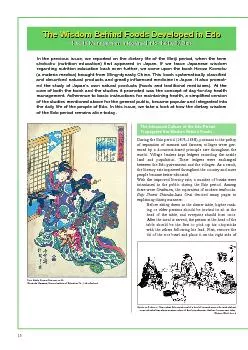/


15 Propagated the Wisdom Behind FoodsDuring the Edo period 1603 ID: 839227
Download Pdf The PPT/PDF document "In the previous issue we reported on the..." is the property of its rightful owner. Permission is granted to download and print the materials on this web site for personal, non-commercial use only, and to display it on your personal computer provided you do not modify the materials and that you retain all copyright notices contained in the materials. By downloading content from our website, you accept the terms of this agreement.
1 15 In the previous issue, we reported on
15 In the previous issue, we reported on the dietary life of the Meiji period, when the term(nutrition education) first appeared in Japan. If we trace Japanese wisdomregarding nutrition education back even further, we come upon the book (a materia medica) brought from Ming-dynasty China. This book systematically classifieded the study of JapanÕs own natural products (foods and traditional medicines). At thecore of both the book and the studies it promoted was the concept of day-to-day healththe daily life of the people of Edo. In this issue, we take a look at how the dietary wisdom Propagated the Wisdom Behind FoodsDuring the Edo period (1603Ð1868), pursuant to the policyof separation of samurai and farmers, villages were gov-erned by a document-based principle rare throughout theworld. Village leaders kept ledgers recording the arableland and population. These ledgers were exchangedbetween the Edo government and the villages. As a result,the literacy rate improved throughout the country and morepeople became better educated.With the improved literacy rate, a number of books wereintroduced to the public during the Edo period. Amongthese w
2 ere Oraibutsu,the equivalent of modern t
ere Oraibutsu,the equivalent of modern textbooks.Doji Shorei Shitsuke-kata Oraidevoted many pages toexplaining dining manners:Before sitting down to the dinner table, higher rank-ing or older persons should be invited to sit at thehead of the table, and everyone should bow once.After the meal is served, the person at the head of thetable should be the first to pick up his chopstickswith the others following his lead. First, remove thelid of the rice bowl and place it on the right side ofFujin Ichidai Kagami Kuizome no Zu(Kunisada Utagawa; Kumon Institute of Education Co., Ltd.collection)Higoto no Kokoro-e;This modest Edo period meal of a bowl of rice and soup with a side dish seton an individual tray shows an atmosphere of family togetherness that has become rare today. (National Diet Library) The Wisdom Behind Foods Developed in Edo 16 should it become nec-essary. Dishes placed onwas published in 1697. This book exam- Tosho E-iri Doji Shorei Shitsuke-kata Orai(Ikku Shigeta; Kumon Institute ofEducation Co., Ltd. collection)illustrates the proper way(Kasen Yamakawa;Kumon Institute ofEducation Co., Ltd.collection) 17were widespread. Another
3 book by Ekiken Kaibara, Yojo-was repres
book by Ekiken Kaibara, Yojo-was representative of such theories. Ekiken states thathuman life is a gift and that a long life is possible bypaying attention to personal well-being. In short, the lengthof oneÕs life is relative to the degree of awareness andattention to health. He also wrote that while eating anddrinking are necessary for sustaining life, both should beproperly controlled as they embody the avarice presentwithin us, and therefore should not be done in excess.Ekiken Kaibara wrote Yojo-kunbased on his own experi-ences in life, as well as his wide knowledge of medicine,Confucianism, and other academic studies. It has beenwidely read and remains so to this day. The book explainsways in which to maintain a happy and healthy lifestylefrom both physical and spiritual aspects. One of the manyissues covered to make health management easily under-stood by the general public, examples of food combina-tions that may be harmful were described. Some of thecombinations Ekiken advised against were rabbit and ginger,rabbit and Japanese mustard, and rabbit and venison.Knowledge of ill-suited combinations like these werebased on human exper
4 ience and then applied to healthmanageme
ience and then applied to healthmanagement. Another book, Edo Shigusa,was popular with Edo towns-people. Edo Shigusadiscussed issues of health, humanrelations, and peace. The health section explained thatmeals should invigorate people and be a source of energy.The human relations section discussed the proper sharingof food, with consideration for age and physical condition,so that none was wasted. Using mackerel or bonito as anexample, the book recommended that the easily digestedlean meat should be given to the elderly while the fattyportions be given to those who are young and full of energy.Edo Shigusapensive and readily available daikonradish or tofu. Amongthese were meals designed specifically for ill people.During the Meiji period (1868Ð1912), an establishmentsimilar to the modern hospice or nursing home servedmeals very similar to those described in Themeals were not only healthful but also comforting. Knownas goho no kaorismall mounds of cooked rice on a large plate, each topped Nanju Byochi illustrates treatment of the 1858 cholera epidemic. (Juntendo University collection) held on May 5th had Shonin-doÒEdo ShigusaÓ no Chie-bukur